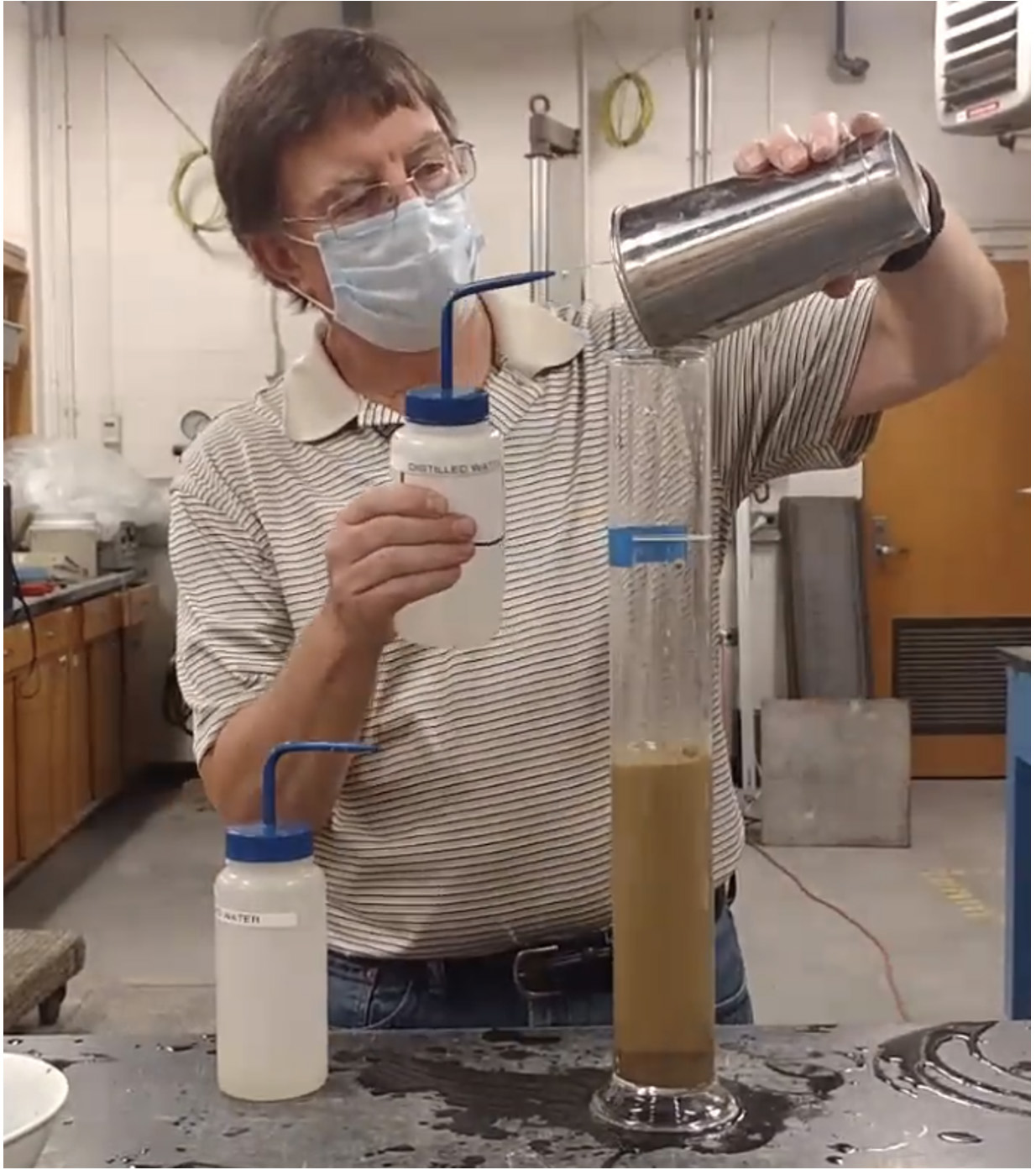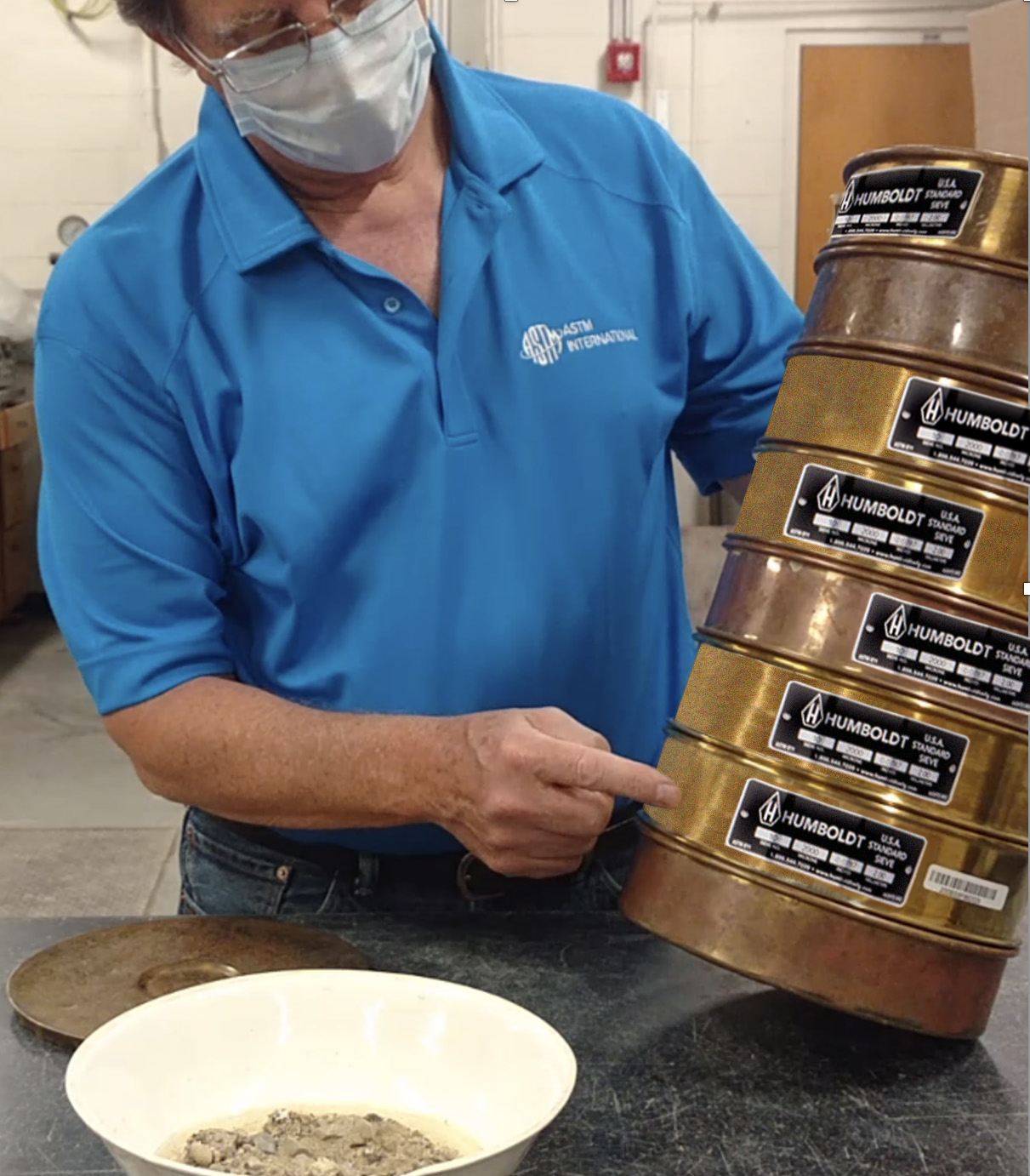D6913 and D7928 Replace D422 Particle Size Analysis
- January 6th, 2022
- Category: Announcements, Guest Posts

This guest post was written by Jack Germaine. He is a Research Professor of Civil and Environmental Engineering at Tufts University.
Determination of the particle size distribution (PSD) is one of the most requested soil characterization tests. The results are used for classification and estimation of engineering parameters. These measurements are made by nearly every geo-testing laboratory. Unfortunately, the scatter in PSD results is far from acceptable. The AASHTO Resource proficiency test program data provide an excellent example of this scatter. In an effort to improve the situation, ASTM Committee D18 on Soil and Rock has discontinued the use of D422/D421 for measuring the particle size distribution of soils. D422 has been replaced by two new standards. D6913 is the standard for the sieve analysis of the coarse-grained portion and D7928 is the standard for the sedimentation analysis of the fine-grained portion.
Professor Germaine of the Civil and Environmental Engineering Department at Tufts University and past Chair of Committee D18 was involved in the original decision to replace D422 with the new standards. He was also a member of the task group charged with writing the new standards and is now the technical contact for revisions.
The decision to drop D422 was made nearly 20 years ago. It then took about 15 years to develop and ballot the new standards. D6913 was first passed in 2004 and D7928 in 2017 so both have been around a significant amount of time. D422 was retained as an active standard until 2016 in order to ease the transition. Unfortunately, adoption of the new standards has been very slow for a variety of reasons. D422 is deeply entrenched in the profession. It is widely specified in building codes, construction specifications, and various government agency documents. In addition, most labs routinely perform the test procedure and inspection agencies provide certification. The combination of these factors with the length of the new documents has proven a formidable obstacle to acceptance.
D422 has been criticized over the years for a variety of shortcomings. The primary concern is the fact that it is a one size fits all standard.
The procedure requires the following steps:
- Air dry
- Separate on the #10 sieve
- Sieve the retained portion
- Hydrometer on the passing portion
- Wash on #200
- Sieve the retained portion.
The results are then combined to obtain the complete PSD. This process is fine for some soils but not for all soils. Air drying takes time, creates clumps, and can alter some clay minerals. Handling large quantities of dried soil creates a dust hazard and promotes segregation of the fines from the coarse particles. It is not always necessary to perform both a sieve and sedimentation analysis. It is a waste of time and money to run a hydrometer on a clean sand or perform a sieve analysis on a fine-grained sample.
There are also several serious technical concerns with D422. The standard lacks controls on the procedures used for sampling and subsampling the material. This is likely the primary cause of scatter in the results. The standard has an inconsistent criterion for the amount of material required for the test specimen. The criterion is based on the maximum particle size in the sample but requires too much material for the 3/8 inch size and far too little material for the 1.5 inch and above sizes. It does not specify how to reduce the mass of material from the whole sample to the test specimen nor does it address subsampling the plus #10 fraction.
The new standards address the limitations of D422 and are based on sound physical principles with consideration of material attributes. The standards provide different workflows to accommodate the maximum particle size, the amount of material available, and need for other types of tests. These workflows provide the quality control measures necessary for precision in the test results and allow variations in the procedure to improve testing efficiency.
The standards require one to report the mass passing values for a given size to 1%. Setting such a target, makes it possible to establish defendable controls. This criterion is the basis for calculation of the minimum dry mass requirement based on the maximum particle size. It limits the impact of having one of the largest particles being included or excluded from the analysis. The criterion is applied to collection of the test specimen as well as any subsamples obtained for various parts of the analysis. It provides a simple unified criterion for any step in the process. It also allows the technician to use different sieves to separate samples depending to other tests being performed or to adjust for different grain size distributions. It has however, dramatically increased the required specimen mass when dealing with materials with large particles.

Making sure the sieving operation has been effective, is a serious concern. D6913 has added two controls for this. The first is called the overloading criteria. This sets the maximum mass that can be retained on a given sieve at the end of the sieving operation. The calculation is based on the mass of a layer of the particles that will completely cover the surface of the sieve. The number of allowable layers vary from 1 to 6 as the particles get smaller. The limit is intended to make sure that each particle has an opportunity to pass through an opening. The second control is the requirement to evaluate the effectiveness of the sieve shaker. The standard provides a detailed process to evaluate the equipment and sets a numerical criterion for passing.
D6913 is a long standard primarily because it provides flexibility to accommodate different materials and situations. Given the constraints established by the minimum specimen mass and the sieve overloading, it becomes necessary to perform the sieve analysis in segments. The standard as 3 different workflows based on the maximum particle size. Single set sieving uses one rack of sieves and is applicable when the maximum particle size is about 3/8 inch. Single separation composite sieving uses two racks of sieves and is applicable when the maximum particle is about 1 inch. Double separation composite sieving uses three racks of sieves and used went the maximum particle is above 1 inch.
D6913 provides options to make the process easier and more efficient. For example, one can obtain the dry mass of a sample or subsample in two different ways. The dry mass can be obtained using the sample prior to testing or based on the moist sample mass and a companion sample water content. For samples with few fines, drying and then processing is fast and easy. However, high fines content materials are easier to process in the moist condition, so the companion sample approach works better.
The sedimentation standard, D7928, is very similar to the hydrometer portion of D422. The procedure covers processing from the minus 3/8 inch size with the test performed on <#10 or finer material. The results are presented as a percent passing the #10 (or finer) size. The material must be prepared in the moist condition. The dispersant is added as a powder and the slurry is tempered overnight. The hydrometer dimensions are changed to meet the currently available equipment. A hydrometer calibration equation is provided to eliminate the need for running a companion cylinder. The changes are minor but make testing more efficient.
The new standards are longer and more complex than D422. I believe it will take considerable education and training to gain acceptance of the standards by the profession. However, once a laboratory has set their internal procedures, testing should be as easy and faster than using D422. ASTM and D18 are proactively engaged in providing education tools. For example, elearning modules are in development which are expected to be available this summer. These training videos will provide visual support for the procedures as well as illustrate example workflows to show how the standard is applied to various materials. In addition, video content will be added to the standards to illustrate the procedure in practice. Several months ago, I presented an ASTM webinar providing background on the development of the two standards. This webinar is available for free at this by clicking here.
Become involved! ASTM standards are constantly being revised through the consensus balloting process. D7928 is being balloted at the subcommittee level and D6913 is being revised for balloting this summer. If you have an interest in voicing an opinion, it is easy to join ASTM and become involved in the standards development process. There are no qualification requirements to become a member and the cost is only 75$ per year. For more information use this link.
For more information about this article and the equipment needed to do this type of testing, please contact Humboldt or Jack Germaine.

